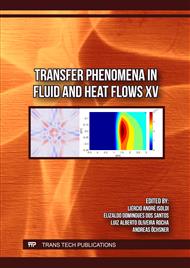[1]
A.F. Miguel, L.A.O. Rocha, Tree-shaped flow networks fundamentals, in Tree-Shaped Fluid Flow and Heat Transfer, Springer, New York, 2018.
DOI: 10.1007/978-3-319-73260-2_2
Google Scholar
[2]
A.F. Miguel, Natural flow systems: acquiring their constructal morphology, Int. J. Des. Nat. Ecodynamics. 5 3 (2010) 230-241.
DOI: 10.2495/dne-v5-n3-230-241
Google Scholar
[3]
A.F. Miguel, Occlusions in dendritic flow networks, Physica A. 535 (2019) 122473
Google Scholar
[4]
A.F. Miguel, A study of entropy generation in tree-shaped flow structures, Int. J. Heat Mass Transf. 92 (2016) 349-359.
DOI: 10.1016/j.ijheatmasstransfer.2015.08.067
Google Scholar
[5]
B. Soni, A.K. Nayak, A.F. Miguel, Gas flow in occluded respiratory tree: A new matrix-based approach, J. Fluids Eng. 144 (2022) 071207
DOI: 10.1115/1.4053124
Google Scholar
[6]
A. Bejan, Shape and Structure, From Engineering To Nature, Cambridge University Press, Cambridge, 2000.
Google Scholar
[7]
A. Bejan, A. Evolution in thermodynamics, Applied Physics Reviews 4, 2017.
Google Scholar
[8]
A. Bejan, S. Lorente, Design with Constructal Theory, John Wiley & Sons, Hoboken, 2008.
Google Scholar
[9]
C.D. Murray, The physiological principle of minimum work applied to the angle of branching of arteries, J. Gen. Physiol. 9 (1926) 835-841.
DOI: 10.1085/jgp.9.6.835
Google Scholar
[10]
W.R. Hess, Über die periphere Regulierung der Blutzirkulation, Arch. Ges. Physiol. 168 (1917) 439-490.
DOI: 10.1007/bf01681580
Google Scholar
[11]
V.R. Pepe, A.F. Miguel, F.S.F. Zinani, L.A.O. Rocha, Fluid flow through isomeric constructal networks of tubes, J. Porous Media. 27 5 (2024) 1-18.
DOI: 10.1615/jpormedia.2023049512
Google Scholar
[12]
V.R. Pepe, A.F. Miguel, F.S.F. Zinani, L.A.O. Rocha, New insights into creeping fluid flow through dendritic networks: A constructal view, Int. Commun. Heat Mass Transf. 139 (2022) 1-12.
DOI: 10.1016/j.icheatmasstransfer.2022.106409
Google Scholar
[13]
V.R. Pepe, L.A.O. Rocha, F.S.F. Zinani, A.F. Miguel, Numerical study of Newtonian fluid flow in T-shaped structures with impermeable walls, Defect Diffus. Forum. 396 (2019) 177-186.
DOI: 10.4028/www.scientific.net/ddf.396.177
Google Scholar
[14]
V.R. Pepe, L.A.O. Rocha, A.F. Miguel, Optimal branching structure of fluidic networks with permeable walls, BioMed Res. Int. 2017 (2017) 1-12.
DOI: 10.1155/2017/5284816
Google Scholar
[15]
P.J. Roache, Quantification of uncertainty in computational fluid dynamics, Annu. Rev. Fluid Mech. 29 (1997) 123-160.
DOI: 10.1146/annurev.fluid.29.1.123
Google Scholar
[16]
I.B. Celik, U. Ghia, P.J. Roache, Procedure for estimation and reporting of uncertainty due to discretization in CFD applications, J. Fluids Eng. 130 (2008) 1-4.
DOI: 10.1115/1.2960953
Google Scholar
[17]
C.H. Zhang, Y. Liu, R.M.C. So, N. Phan-Thien, The influence of inlet velocity profile on three-dimensional three-generation bifurcating flows, Comput. Mech. 29 (2002) 422-429.
DOI: 10.1007/s00466-002-0352-9
Google Scholar
[18]
Y. Liu, R.M.C. So, C.H. Zhang, Modeling the bifurcating flow in a human lung airway, J. Biomech. 35 (2002) 465-47.
Google Scholar
[19]
C.D. Murray, The physiological principle of minimum work applied to the angle of branching of arteries, J. Gen. Physiol. 9 (1926) 835-841.
DOI: 10.1085/jgp.9.6.835
Google Scholar
[20]
A.F. Miguel, An assessment of branching asymmetry of the tracheobronchial tree, Sci. Rep. 12 (2022) 10145.
Google Scholar
[21]
S. Chen, A.F. Miguel, M. Aydin, A constructal hemodynamic study of bypass grafts with size constraint, J. Porous Media. 26 (2023) 37-48.
DOI: 10.1615/jpormedia.2023044761
Google Scholar
[22]
A F. Miguel, Blood flow through a 3D stenosed artery and its constrained bypass graft design, Res. Biomed. Eng. 40 (2024) 297–305.
DOI: 10.1007/s42600-023-00330-7
Google Scholar



